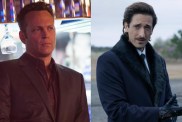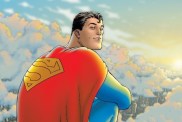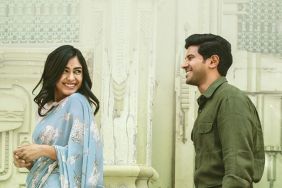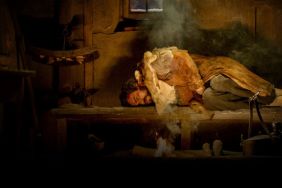There are tens of thousands of young filmmakers out there hoping to make their first movie and of the thousands of first movies that see the light every year, a scant few of them will leave any sort of lasting impression or impact. That’s why you may want to remember the name of Joachim Trier, a fresh and original filmmaker who set his first feature film Reprise in his former hometown of Oslo, Norway of all places. It tells the story of 20-year-old friends whose hopes of becoming famous authors like their literary idol don’t go the way they planned and shows how each one of them deals with the roadblocks that come along with one’s quest for fame. It’s handled in a way that’s far more intriguing and entertaining than a mere plot summary could ever do justice that’s drawn comparisons between Trier and Trainspotting era Danny Boyle. It’s also won numerous festival awards including the coveted Discovery Award at last year’s Toronto Film Festival before finally being released here by Miramax.
ComingSoon.net sat down with Trier at the prestigious Soho Grand in New York City to talk about this intriguing film and some of his musical and film influences.
ComingSoon.net: I watch so many movies but this may have been the first movie I’ve seen based in Oslo, and I’m surprised by that. It’s also such a rich movie that I almost feel like I have to watch it again.
Joachim Trier: Oh, thanks… Good, because that’s the title, “Reprise.” People have made comments, “Yeah, it’s quite dense…”
CS: That would be a good quote for it, “Reprise, you’ll want to see it again.”
Trier: Maybe this is an angle? “A film you must see it again”?
CS: What was the original seed of an idea that started the whole thing rolling? I know that you and your writing partner Eskil Vogt were trying to write something else together, a book maybe, and that eventually became this?
Trier: We didn’t write a book. We were working on a big English language thriller conceptual Cold War thingie, and it just turned sour on us. It just didn’t work out, but we started having all these other ideas, so we said, “What is this about? It’s about Oslo and nostalgia…” I’d been for seven years in London, so it was about nostalgia but it was about representing an environment in Norwaynot to come off as a hip-hop guy saying, “I’m representin’ the Oslo ghetto.” No one was talking about the kinds of people we knew. My little brother was the age of the characters in the film and with his bunch of friends, it was kind of the ennui of young people who have tons of choice, that they were building up their identity by cultural references internationally, but didn’t know where to go. I just wanted to portray it, because it’s an interesting moment in people’s lives. I guess it came out of that, but there were also millions of other things like a formal idea here, a character there, a Henry James short story “Lesson of the Master” that we were inspired byas a training wheel, so to speakit was just inspiring in terms of its theme, but actually, it doesn’t resemble the film anymore. Various, many sources, scattered, much like the film.
CS: You talk about having dreams when you’re young, but when you think about it, not a lot of the culture from Oslo and Norway gets out of the country much, even though the country produces many films, art and music.
Trier: Absolutely. It’s actually beyond expectations. We were hoping for this to happen with “Reprise,” rather to make a film that hits the right bunch of people in every city that it goes to rather than to hit everyone in one country. I never think of a target audience but obviously I want this film to speak to people who might be like-minded or understand the themes. Having it be exported to 30 countries is great, it’s really good for the film because locally, it did okay. It wasn’t a blockbuster obviously, so it’s great that it can travel and reach more people that way.
CS: Actually, I was thinking more about the characters themselves, about being young and wanting to write a great novel but also wanting to get out of Oslo.
Trier: Yeah, the immigration theme. It’s interesting that there’s a literary tradition of that in Norway. Ibsen wrote “Peer Gynt” in Italy, Knut Hamsun always traveled. Munch, the painter, certainly did most of his interesting work in Berlin and Paris. There is this old tradition of that, and I think Norway has sort of a wintery cold dark claustrophobia to it and it’s healthy to get away, if not for the cultural claustrophobia than just the seasons of winter. Young people writing books and young people going abroad, those things are very usual. I know people react to it internationally say, “That young crowd wouldn’t write books” but in Norway, absolutely. There’s a big booming young literary milieu right now, which is great, really interesting young writers.
CS: Why did you want to set their story within the literature world of Norway?
Trier: I think because of the literary traditions, and I was interested in the fact that they will travel abroad, but they’re still encapsulated by their own language. As a filmmaker, you can travel abroad and make films in various languages, but I think in terms of being a writer, except for Beckett and Nabokov, most people write their own language whether they move abroad or not. I thought that was an interesting them as well. I also needed a shared passion between someone, intellectual aspirations. A lot of films about young people that age are so condescending, and they’re all about getting the girl or getting a bourgeois life or getting material goods, getting a conventional life somehow, and I think these guys aspire to something else. Maybe for a more narrow kind of literature, and I think that’s sympathetic on some level. I wanted to talk about that.

CS: It’s interesting you see the film as being optimistic because it does have pessimistic undercurrents… “This is what might have happened, but no, not really, this is what happens.” Was that a part of the plan from the beginning?
Trier: Without revealing much to the readers, I think that the ending opens up a question rather than saying, “It has to go this way or another, but at least life and creativity certainly is a process, an ongoing theme, it’s not something that can be fixed by resolution.” I guess that’s the spirit of the film, that process.
CS: You also really created two movies about these guys, one that was about two minutes long, and then the actual movie.
Trier: We call it the overture, the dream sequence. I thought it was interesting to portray friends through their shared ideas and shared dreams, because that’s what it is. We thought it was an original way of introducing the characters and their ideals.
CS: I know that the two characters don’t represent you and Eskil…
Trier: We get that question a lot. It’s not biographical.
CS: But did you each have a character that you related to more or thought you had a better handle on to write?
Trier: We mixed it up. We’ll sit and we go through everything. We basically spent all our writing time together in the same room, which is tiring and it takes a long time, but it’s really good and it makes me well-prepared when we go to shoot the film. I’m able to liberate and free it up because I’m so confident about what intentions thematically work for the various scenes. We went through discussions in great detail because we wrote it together. But to answer your question about the biographical aspects of it, yeah, environment, milieu, certainly it’s not like one character is me and the other is Eskil, but you try to put yourself into all the characters. I was really heartbroken when we were about to shoot the film. My girlfriend and I had split up, and I felt really close to Kari for one moment or the “Joy Division jogger.” At some other point in the writing process, a year earlier, I felt a bit like Philip. I lost faith in the project when “Reprise” went through a hard script stage, and there’s always a bit of Erik in all of us. We were talking about the Erikness of Norwegian neurosis and politeness.
CS: There’s a lot of different types of Norwegian men in this, so were you trying to show a good cross-section of what they’re like?
Trier: Not sociologically, that’s not how I think either to be honest with you. I wanted it to be culturally specific. It’s about specific characters in a specific environment, but between them, I think they’re quite a varied bunch of guys, particularly in their relationship to women, I wanted there to be more types of guys. We have the insecure misogyny of Lars, then we also have the yearning that Philip has with a sincere relationship and an inability to feel or be certain of one’s own feeling of identity. Then you have Henning, the old punk rocker, who seems to be an ***hole but gets married at the end.
CS: Henning was pretty funny. You listen to what he says and he comes off like an idiot but then you think about it and go, “Oh, maybe he’s right… no, no, he’s wrong.”
Trier: I think he’s the common ***hole in any bunch of guys. You know you love your ***hole friends sometimes even though you’re ashamed to admit it, particularly with the dynamic of boys and girls in the film. I really wanted to portray the double-sidedness. There’s a scene by the sea when they’re out swimming and the woman comes to meet the boys, it’s like Erik is torn in between. In a way, they’re all right and all wrong.
CS: I know you’ve done some short films so how did you approach doing a full-length feature? How long did it take to get the script together and once you figured out what you wanted to do, how did you approach such a complex film?
Trier: Actually, we wrote it many, many, many times. We had tons of ideas. We went too long just gathering ideas and we ended up possibly that we could have written a one thousand page script no problem. We could have done a TV series out of this, but this was not the form we wanted to explore, we wanted a feature film. We wanted it to be condensed, one journey. I think we mapped it out and we worked from the outside in. We have a lot of scenes that we liked and we sometimes write them out and aren’t certain where they’re placed yet, then we construct the timeline. It takes time to write that way, but I hope there’s a density to ideas. I enjoyed films myself that have a lot of conceptual ideas or jokes or emotional ways of approaching a scene. I think that’s what makes me curious about cinema.
CS: I think your movie works because all of those ideas comes together, which isn’t always the case. Did you just write a lot of scenes then put them up on a wall to try to figure out how to assemble them?
Trier: Actually, we have a timeline system that we developed during “Reprise” where we do the metric system. We actually do a centimeter a page and we do little pieces of colored paper that we put down–each intrigue or each character or part of the narrative have their own color and we put it out on the timeline to see proportionately how long…”that part is 9 pages, that’ll be 9 minutes.” So you start getting an idea of the structure. “Look at the middle of the film. It’s 20 minutes of only Kari and Philip. We need to get Erik in there.” So we try to find a musical or a structural way of looking at the film from the outside, not just from pages of writing.

CS: Did the script end up pretty much in the form of the movie?
Trier: Absolutely. It’s completely like a standard format script, but having said that, there’s a lot of scenes and cuts and (for financial reasons) we did write it so that people will get an idea what the film will look like in terms of editing, even though shooting it with actors, they can’t shoot it with jump cuts obviously, so we to do a lot of the scenes linearly for the performance but we actually we went back to the script idea in the end scene. The script actually looks quite a lot like the film, luckily. You don’t want it to be exactly the same. You want it to growit’s a live organism making a movie–but certainly, most of those intentions were there.
CS: It’s a great script that would probably be a good read if you ever did an English translation of it.
Trier: Oh, yeah. It’s published in Norway and it’s gotten a lot of attention as a film script because we consciously wanted it to be the raw text. We didn’t make it nice after the film, it’s the shooting script that’s printed and people who are studying film can now read it if they want to if they want alternative ways of expressing themes, because it’s not just continuous dialogue.
CS: A movie like this is hard to categorize, so would you ever try to?
Trier: I’ve been forced to try to. When we were showing the script (around), we said “Read it. I can’t say, ‘it’s about two writers.'” It’s hopefully about something more than that. If you really spend time making a film, it’s hopefully more complex than what you can reduce it to, so it’s a coming-of-age in one way or as one critic jokingly called it “‘American Pie’ made by Tartovsky” which I thought was hilarious.
CS: The movie has a pretty big cast and you mixed it up by casting many non-actors. How did you want to approach finding the cast and did you feel you needed to cast Erik and Philip before anyone else?
Trier: We had to see a lot of guys, because there were a lot of those parts, so we got something like a thousand people. It was amazing because we met a lot of interesting people, and I think I was really looking for relationship in this. There were too main dynamics we needed. We needed Erik and Philip to work as a couple almost and Kari and Philip, so it was a lot about finding the right dynamics. There were some great actors who were individually great who didn’t fit into the bunch of friends for example. I learned a lot from that. It was a good experience. We had people come in and read and hang out and we did workshops. Some people were in 16 or 17 times. They were in for weeks and some people who didn’t get into the film are still people that are our friends in a way and I hope to do something else with them. The film comes first and if they’re wiling to go that extra mile to explore the character before we decided and set the cast, I really very much appreciated that and I think that worked for the film.
CS: I know you did a lot of rehearsals, but when you filmed it, were you able to film the film in any sort of chronological order?
Trier: Not at all. It was all over the place and that was tough, but I certainly protected the actors in terms of not going through too many emotional states at a time per day, because they’re non-professional, they don’t have experience. If someone was really upset and sad, some of those guys would just go home and be miserable for the rest of that day. They really got into that state and you didn’t want them to crack jokes five minutes later. I tried to schedule it from an emotional point of view, but not in terms of the chronology of the story.
CS: When you were rehearsing, did you just go through scenes and not worry about the order where they take place in the movie?
Trier: We went through scenes. We had basically at least 120 to 150 pages of extra material that we’d written as background material, like sideplots that never made it into the final script, so we could give those to the actors and use them as training scenes, so they could explore the characters in other situations than the ones in then film, and through that, I believe I always build up characters, like it’s the tip of the iceberg, like there’s a huge fundament underneath and then you only need to see that top of it. A lot of subtext doesn’t need to make it into the final film, but as long as the actors have that dynamic in them, that’ll make the scenes come alive. I mean, it’s about character detail. I’m incredibly curious and fascinated by that.
CS: I want to ask you about the title of the movie because it’s a simple word that can be read many ways, and the viewer might spend a lot of time thinking about how it fits in.
Trier: Yeah, it can be many things. (We came up with that) very early on and a lot of people went against it and thought it was not a very sexy title for a film, particularly in Norwegian, where it has a connotation of meaning “rerun” on TV. The Kari and Philip story of going back to Paris is certainly one way to look at that, their “reprise,” an event. What about going back or trying to recreate? It’s also about a bunch of guys who do a lot of running jokes and reprising last summers. “Oh, we went out there and hung out and we’re doing it againt this year.” There’s a lot of aspects of reprising, and also, the reprise or the repetition of the career of Sten Egil Dahl. Are we only copies of the people we admire or are we doing something different? I think the title kind of fits me, but I’m sure there are many other ways of looking at.

CS: As far as the music of the film, when you open a movie with Joy Division, you’re making a very deliberate statement. Did you see this movie as a period piece or was it modern day with a sense of nostalgia?
Trier: A lot of this is sort of timeless and iconic. I approached it like I wanted there to be a contemporary feel, and I was very happily living in London where we were writing to see that… mind you, we were writing this way before the Joy Division boom really came. I remember Franz Ferdinand being a new band, first album, or Interpol. That stuff started happening and we were like, “Goodness, it’s happening again” and of course, there’ll always be guys who like the Cure or Joy Division or a lot of those UK or Manchester bands, and also the whole CBGB’s ’70s revival that came. That’s contemporary but there’s a timelessness and all the big brothers of friends ten years older than them that listened to that music and discovered it for the first time. We went through it, my brother’s generation went through it, so it’s rather that tradition rather than thinking, “Okay, what’s the new R&B track? Let’s put that in the movie.”
CS: Was Kommune an actual Norwegian band? I thought it was made up for the movie but I wasn’t sure.
Trier: We created it, but it’s a homage to Turbonegro. There was a lot of ironic punk bands in the 90s, Israelvis and Astroburg. Check em out on the internet. You gotta check out The White Birch, it’s Ola, the guy who made the soundtrack, it’s the first time he’s scored a feature film. This band is marvelous.
CS: Do you think this story could have happened anywhere or do you think it’s very much a product of what it’s like living in Oslo?
Trier: Completely yes and no at the same time. I had some offers to remake the film in America, and obviously, I don’t want that to make that film again. I think it’s perfect where it was put because it’s very culturally specific, and that’s what it needed to be. I couldn’t have made that film anywhere else, but having said that, it seems to resonate with people in other places and that makes me happy. But if I watch a film about a tribe in the jungle or some other culture I’m not familiar with, I’m interested in what’s specific about that and I can recognize something metaphorically in that specificity rather than being general and not interesting to anyone. It’s that paradox of being specific culturally that I also think will make things more interesting to other people.
CS: I know you were born in Denmark and had many Swedes on your crew, so do you see any sort of connection between the films from Norway to those from Sweden or Denmark?
Trier: I tell you what. In Norway, I’m now part of what they call a new Norway scene, but I don’t feel like I belong to any tradition in Norway. I’m a big fan of Drier and Bergman when they had those guys in Norway, and in contemporary cinema, I certainly feel much closer to someone like Jesper Ganslandt that did “Falkenberg Farewell,” a wonderful Swedish film that went to Toronto together with “Reprise,” I think Christoffer Boe is interesting, “Reconstruction,” he’s kind of curiously exploring memory and time.
CS: I also thought I saw a little Susanne Bier in there…
Trier: Really? Oh, I don’t feel I belong in a comparison with her at all, but that’s okay, that’s not up to me to decide.
CS: Also Danny Boyle, which must be the British influence.
Trier: Yeah, someone’s compared it to “Trainspotting” and I didn’t see that either but I surely enjoyed “Trainspotting” when it came out, I loved it.
CS: Scandinavian films don’t always play well in this country and I wondered if you had any insight into that having shown the film here at various festivals.
Trier: The critical reception so far, from the people who have reviewed it, has been very good, but it certainly needs it to be able to be seen, so we’ll see how that goes. It got a great reception in Toronto where it won the Discovery Award, which meant that people responded to it, it wasn’t just the jury. I find that in all countries, there’s a group of people who connect with it. It sounds cheesy but this is a dream come true and I’m really pleased to see that people of different generations and different countries are connecting to these boys, ’cause I’m not going to make a film again about boys that age. I’m working on other stuff now. To me, it’s important that it rings true, those themes.
CS: I know this film has been finished for many months, so what have you been working on since then?
Trier: I’m still working with Eskel, and I think we’ll continue to explore our fascination with stretching the film language into trying to show thought processes but it’s a bit early to talk about the stories yet. It won’t be the same yet I think we’re continuing on that same exploration of ways of telling stories where things are slightly different.
CS: Do you think you’ll stay in that environment or do you think you’ll do an English movie?
Trier: We’re working on an English project, East Coast I think. I love New York and I think there’s stories in America as well that I’d like to possibly tell, so we’ll see how that goes. It depends on the actors in this country a lot, so we’ll see what happens there, but I will try to stay true to our form of combinations of emotion, like serious and funny. I’m interested in trying to match things that aren’t obvious, so we’ll see how that works.
Reprise opens in New York and Los Angeles on Friday, May 16.









